Share this Post
Table of Contents
2019 Update | How This All Started | Combatant #1: Princess Pauline Metternich | Combatant #2: Countess Anastasia Kielmannsegg | The Duel | The Aftermath | Let the Debunking Begin | Sources for the Duel | What the French Newspapers Say | What the Viennese Newspapers Don’t Say | What the Viennese Newspapers Do Say | What Does This Leave Us With?
UPDATE: Thanks to a comment from Dutch historian Ignaz Matthey, it looks like we can debunk the story of this duel. I fell for the fake news! So embarrassing, right? If this is your first visit, read the story of the duel below as I originally wrote it, then stick around for a little debunking at the end. If you already know the story, you may want to jump straight into the debunking.
When I found a post on AtlasObscura.com about a topless duel, I knew I also had to write a post about it. Why? Because the duel took place in 1892 between Princess Pauline Metternich and a fellow aristocrat – a countess, in fact.
Interesting? Check.
Come to find out, they fought the duel topless. This sends the story into WTF territory.
Of course, I had to know more. Here’s what I found out.
Combatant #1: Princess Pauline Metternich
If her name sounds familiar, it’s probably because her grandfather was the famous Austrian diplomat Count Metternich – the one who made like Cher and tried to turn back time after Napoleon’s defeat and exile.
Pauline was born in Vienna in 1836. When she was 20, she married her uncle, Prince Richard von Metternich, which isn’t creepy at all because he was only her mother’s half-brother. At least she didn’t have to order new stationery.
When she was 20, she married her uncle, Prince Richard von Metternich, which isn’t creepy at all because he was only her mother’s half-brother. At least she didn’t have to order new stationery.
Richard was a serial cheater, but the marriage was happy enough to produce three daughters. Because Richard was a diplomat, the couple traveled to Berlin and Paris, where she befriended Empress Eugenie (here’s her pearl and diamond tiara). It was Pauline who introduced the famous dressmaker Charles Worth to the French empress. Nice. I love me some Worth.
She was an ardent supporter of music and the arts and of women smoking cigars. When the French empire collapsed after France’s defeat in the Franco-Prussian war, it was Pauline who sent Empress Eugenie’s jewels to London in her husband’s diplomatic bag. This is a woman you want on your side, in other words. I like her. Here’s her portrait:
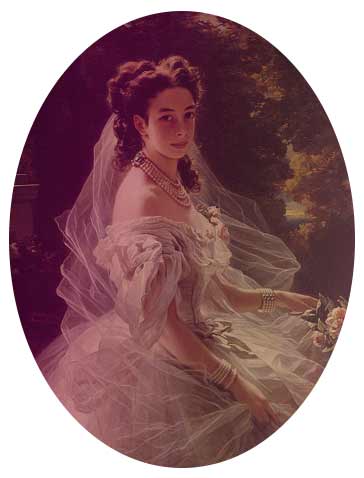
Combatant #2: Countess Anastasia Kielmannsegg
Turns out, Anna was a rival for HBIC on the Viennese social scene. She came from a very wealthy Russian family in Bessarabia (her maiden name was Lebedeff), but that didn’t cut it when it came to measuring up against Austrian nobility. Anna’s husband, Count Erich von Kielmansegg, wasn’t even Austrian – he was German, and Protestant to boot. He was, however, the governor of Lower Austria. His position gave her entree into Viennese society.
UPDATE: Big thanks to Michael, who gave us some fantastic information on Kielmansegg’s family in the comments. Erich was a descendant of an illegitimate child of Ernest August of Hanover (and half-sister to King George I). Erich’s mother was apparently involved in some serious jewel-smuggling shenanigans after Prussia conquered Hanover. This merits further research and, possibly, its own post.
But back to our story…
Even with these social setbacks, Anna was determined to make “fetch” happen. She used her position to score seats on the boards of various charities, and then set out to kick Pauline’s ass at party planning. In general, the starchy nobility preferred Pauline. The masses preferred Anna, according to the Marquise de Fontenoy. I don’t have a flattering Winterhalter portrait for Anastasia – just a grainy image from an old magazine:
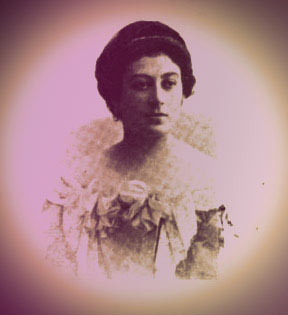
The Duel
In August of 1892, Pauline and Anna had a disagreement over how to arrange flowers for the Vienna Musical and Theatrical Exhibition. Pauline was honorary president, while it seems that Anna was the acting president of the Ladies’ Committee of the Exhibition. Who had the authority to make the final decision? Turns out, the flowers were just the straw that broke the camel’s back. The real cause of their argument was who had the final say as ultimate tastemaker of Viennese society.
Apparently, this was such a big problem for them that they decided to settle things with swords, fighting for first blood on the field of battle in Vaduz, Liechtenstein.

The duel was organized and officiated by one Baroness Lubinska, a fellow noblewoman who had a medical degree. She was the one who insisted they fight topless, since she knew that clothing jammed into a wound often caused sepsis. Far better, she realized, to remove a potential contaminant and prevent any unnecessary deaths. Before you get too excited, “topless” in this case just meant without their blouses. Both women kept their corsets and chemises for the fight.
According to the Los Angeles Times, which reported on the duel in 1892, “It was a real fight, and both were wounded – no hair pulling or plain scratching, but a duel with rapiers…”
According to the Los Angeles Times, which reported on the duel in 1892, “It was a real fight, and both were wounded – no hair pulling or plain scratching, but a duel with rapiers…”
Anna and Pauline exchanged a few weak feints. Then Anna went for broke and slashed out, giving Pauline a cut across the nose. Shocked at what she’d done, she clapped her hands to her cheeks. Pauline, sensing her opportunity, stabbed Anna in the arm. At the sight of blood, both women’s seconds fainted.
At this point, the men present – footmen and coachmen, standing with their backs turned – rushed to help. Baroness Lubinska chased them back with her umbrella since the women were, after all, scantily clad (for the times).
Some sources have the injuries reversed, saying it was Pauline who cut Anna on the nose, and then Anna stabbed Pauline in the arm. Pauline was considered the winner, which makes me think she’s the one who did the arm-stabbing. There’s no way a glancing nose blow beats a stab through the arm.
The Aftermath
Okay, so there really wasn’t much of an aftermath. I mean, dude, it was about flowers. And no one died. According to the Pall Mall Gazette, their seconds asked the women to make up immediately after the fight, and no one reports they didn’t, so we must assume they did.
There are a few interesting tidbits about Pauline’s kids.
- Pauline’s second daughter, Pascaline, married Count George of Waldstein, who was insane and murdered her in an alcoholic delerium in 1890.
- Pauline’s third daughter, Clementine, was mauled by a dog as a youngster. Her face was scarred so badly she chose never to marry.
I’m not sure there’s a lesson here. If there is, it’s that you should swordfight topless and keep an eye on your kids and dogs.
2019 Update: Let the Debunking Begin
On February 27, 2019, a reader named Ignaz Matthey left a comment letting me know this whole story wasn’t true. He had evidence on his side – a statement from Pauline Metternich printed in a French newspaper.
He also had logic on his side. He pointed out that the memoirs of Madame de Fontenoy (real name: Marguerite Cunliffe-Owen) don’t mention this duel at all, despite going into detail about each woman and the rivalry between them. If de Fontenoy had privileged access to the highest levels of Viennese society, why would she leave out such a tantalizing story? It was a question I couldn’t answer.
If de Fontenoy had privileged access to the highest levels of Viennese society, why would she leave out such a tantalizing story?
So I went back to the sources for a second look. Were any of them primary sources? Nope. All we have are secondhand accounts – newspaper writers saying they picked up the story somewhere else. So I went looking for a few new sources.
Sources for the Duel
It doesn’t look like Anastasia Kielmansegg left us any of her writing (letters, diaries, etc.) – at least not any that are published and easily traceable. Pauline Metternich did write her memoirs, but they only covered her childhood and the years she spent in France. She didn’t write about her later years in Vienna, when this duel took place.
Without a confirmation from the participants, what are we left with?
Turns out, the only places I can find that reported on it were newspapers. Even a couple later non-fiction books on dueling that mention Pauline and Anastasia cite newspapers as their source.
What the French Newspapers Say
I found a French newspaper, Le Radical, which published the story on August 23, 1892. They said they got it from another French newspaper, Figaro, who got it from Vienna. When I looked up Figaro, I found the story published on August 20, 1892. Here’s the opening line: “An astonishing story that comes from Vienna, where it’s guaranteed exact.”
“An astonishing story that comes from Vienna, where it’s guaranteed exact.”
Le Radical

Erm…really? If it’s guaranteed exact, why not print the name of the source? Or at least give us a hint, like, “According to someone who was there…” The story goes on to give us the now-familiar details: the duel took place in Vaduz, Pauline got a scratch on the nose, and Anastasia was wounded in the arm.
This brings us to the specific paper my commenter found, Gil Blas.
On August 26, 1892, they printed the following statement (roughly translated from the original French, shown below), and appended a telegram from Pauline, sent a few days earlier on August 22: “The alleged meeting with the sword which would have taken place between Madame de Metternich and the Countess Kielmandsegg [sic] is definitively denied by this dispatch: Esztergom, 22 August, 8 h 40. Stupid and ridiculous canard invented by Italian newspapers. Princesse de Metternich.”
“Stupid and ridiculous canard invented by Italian newspapers.”
Princesse de Metternich
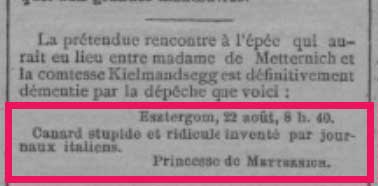
Okay, so if this dispatch from Pauline is the real thing, she’s saying an Italian newspaper was the source, not an unnamed person in Vienna who reported to Figaro. Even so, if we can find mentions of this duel in Parisian newspapers, you’d think Viennese newspapers would have a field day if two of their society’s leaders tried to cut a bitch with swords, right?
It was time to dig deeper.
What the Viennese Newspapers Don’t Say
So I tried to do a little better using Viennese papers as my source.
First of all, this is a lot harder than it seems because (a) I don’t speak German, and (b) I can’t read German script. But here’s the thing. If the duel had taken place, wouldn’t newspapers have devoted plenty of ink to such a scandalous (and sales-worthy) story? Pauline wasn’t a member of the royal family, so it was far less likely to be censored than scandalous details about, say, an archduke.
I didn’t find any stories reporting the duel.
Granted, this was a quick search done in about an hour. Did I read every paper for the month of August? Nope. But searches for “Metternich” and “Kielmansegg” gave me nothing. Count Kielmansegg came up in a fair number of searches, mostly because there was speculation that he was about to be nominated to a position of influence as a government minister.
What the Viennese Newspapers Do Say
I did, however, find two articles that denied the story.
The first came on August 13, 1892 in the New Vienna Daily (Neues Wiener Tagblatt) under the headline “Noble aristocratic duel.” The article noted how amusing it was when other countries’ newspapers fabricated stories about Vienna. The article mentioned previous fake news about the city that had been printed in Russian and American papers. The American one, for example, had reported a massive flood in Vienna that apparently never happened.
This article, however, cites an Italian source for the duel story – which tallies with Pauline’s denial. “This time,” the paper reports, “it is the ‘Tribuna’ in Rome that knows how to tell a very sensational and spicy story.” The Vienna paper reprints a big chunk of the story, and then says the two women would be very surprised to learn that they’d ever stood opposite each other with weapons in their hands.
The Vienna paper reprints a big chunk of the story, and then says the two women would be very surprised to learn that they’d ever stood opposite each other with weapons in their hands.

But that’s not all.
On August 21, the Wiener Caricaturen printed a similar story. This one has no headline – it’s tucked in a collection of small stories on page 2. It floats a theory that the duel story was a satire, a not-unexpected move from a publication titled “Viennese Caricatures.” It mentions, roughly translated, the “tantalizing siren’s call of that Italian newspaper correspondent, whose amusing lines were read by so many last week about the saber duel between Princess Metternich and Countess Kielmansegg.”
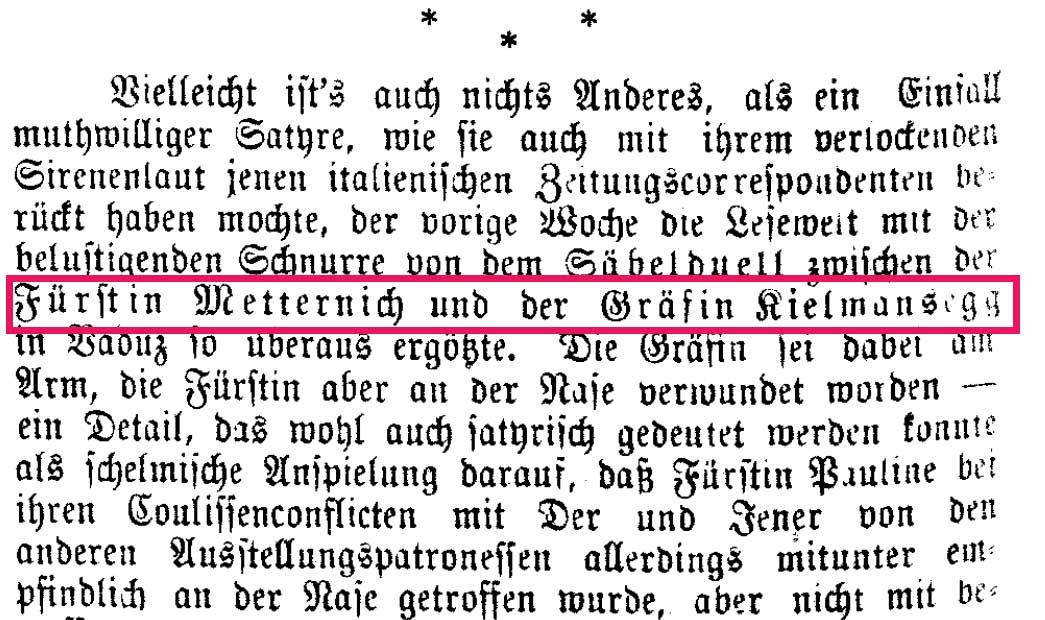
Why would they think it might be satire?
Because Pauline was wounded on the nose, “a detail that could probably also be interpreted satirically as a mischievous allusion to the fact that that Princess Pauline in her conflict with the other exhibition patronesses, was sometimes sensitive to the nose…”.
Now, we know that Pauline was sensitive about her looks.
In France, she referred to herself as “le singe à la mode” (the fashionable monkey). The Winterhalter portrait I posted above is, like all Winterhalter portraits, designed to flatter the sitter. Here’s a photo of Pauline, probably from the 1860s:
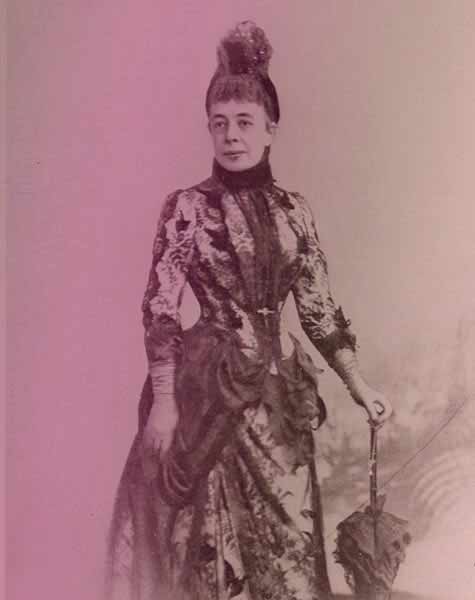
The Wiener Caricaturen goes on to report that “All this, however, is a thing of the past, and today Princess Pauline is the undisputed sole ruler in the exhibition…”
So all’s well that ends well, at least for Pauline.
What Does This Leave Us With?
You tell me. Nothing is 100% certain because we don’t have an eyewitness statement from any duel participant in their own hand. Even Pauline’s statement in the newspaper is technically secondhand.
We have no statements from police reports, no memoirs, no published letters where the supposed participants told the truth because it was off the record. We only have newspapers saying it happened versus newspapers saying it didn’t happen.
We only have newspapers saying it happened versus newspapers saying it didn’t happen.
Still, it’s unlikely that Gil Blas would have printed a fake denial from Pauline. Assigning specific words to people when they didn’t say them is a step too far, even for unscrupulous news writers. If they were going to print something fake, far better to say something vague like, “Those involved have so far denied involvement” or what have you. But that’s not what we have here.
Also, we need to think about the second point raised by my commenter.
People who wrote memoirs about Austrian court and high society of the time didn’t mention this. The Marquise de Fontenoy wasn’t the only one. You also have Princess Catherine Radziwill (The Austrian Court from Within), Nellie Ryan (My Years at the Austrian Court), and Amelia Sarah Levetus (Imperial Vienna). None of them mentioned this duel.
All of which leaves me feeling a bit deflated. This duel falls into the “if it sounds too good to be true…” category. And, apparently, it is. On the plus side, I’m all for historical accuracy, even at the cost of a fantastic story. So cheers to Ignaz Matthey for bringing this up!
Image credits
Pauline, header: Edgar Degas, public domain via Wikimedia Commons
Pauline, portrait: Franz Xaver Winterhalter, public domain via Wikimedia Commons
Anastasia: The Lady’s Realm, public domain via Google Books
Vaduz: Norbert Aepli, CC BY 3.0 via Wikimedia Commons
Pauline, photo: Unknown photographer, public domain via Wikimedia Commons

Love Royalty and Tiaras?
You might like my other site, The Girl in the Tiara. I created it to write about amazing royal women and their tiaras. It’s like Drunk History meets The Crown.
Share this Post
